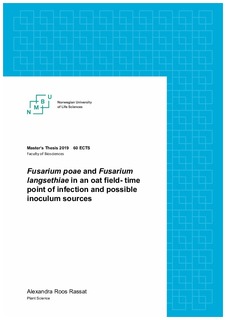| dc.description.abstract | Fusarium head blight in cereals is a global issue, threatening food production and food security. Most Fusarium head blight organisms are able to produce a wide range of mycotoxins, posing human- and animal health risks related to consumption. However, over the past decades the prevalence of the two trichothecene producing Fusarium species F. poae and F. langsethiae has increased in small grain cereals in European and Nordic countries. Despite the increased prevalence of these problematic Fusarium species contaminating cereal grains, little is known about their biology.
Oat plants collected during two consecutive growth seasons, 2017 and 2018, from a Norwegian oat field were analysed for the presence of F. poae, F. langsethiae, F. avenaceum, F. graminearum, F. culmorum and F. sporotrichioides. Oat plants were collected weekly to examine the time point of initial infection of F. poae and F. langsethiae in the field. In accordance with other studies, our observations indicate that initial infection of oat plants by F. poae and F. langsethiae occur prior to flowering, supporting the hypothesis of their biology differing from other Fusarium head blight pathogens, infecting cereals around flowering. To our knowledge, this is the first field study analysing the relationship between abnormal oat plants and infection of F. poae and F. langsethiae. Abnormal oat plants were significantly more infected with F. poae and F. langsethiae than normal oat plants.
Oat grains harvested both years, were morphologically- and molecularly analysed for presence of Fusarium DNA, in addition to mycotoxin analyses.
The gramineous weed P. annua was investigated as possible source of F. poae and F. langsethiae inoculum. Fusarium DNA in P. annua plants was quantitatively assessed by running species-specific qPCR analysis. Low levels of F. poae DNA and negligible levels of F. langsethiae DNA were observed in P. annua plants throughout the growth season.
Analysis of Fusarium DNA in air samples provided new information of high levels of F. poae and F. langsethiae DNA in air samples, around ripening, which emphasizes the possibility of inoculum being dispersed by air. | nb_NO |

